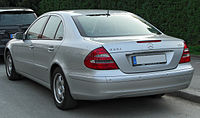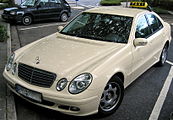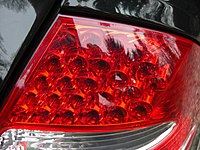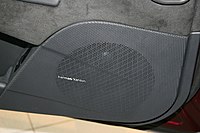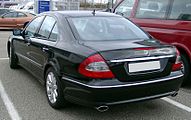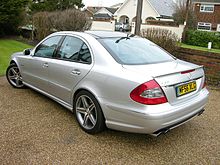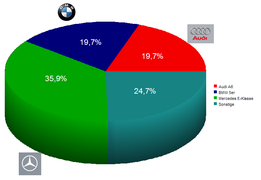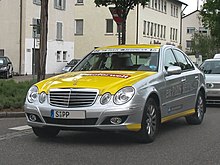Mercedes-Benz model series 211
| Mercedes Benz | |
|---|---|
|
Mercedes-Benz E 220 CDI Classic (2002-2006)
|
|
| 211 series | |
| Sales designation: | E class |
| Production period: | 2002-2009 |
| Class : | upper middle class |
| Body versions : | Limousine , station wagon |
| Engines: |
Otto engines : 1.8–6.2 liters (120–378 kW) Diesel engines : 2.1–4.0 liters (75–231 kW) |
| Length: | 4852-4884 mm |
| Width: | 1822 mm |
| Height: | 1483-1506 mm |
| Wheelbase : | 2854-3600 mm |
| Empty weight : | 1570-1990 kg |
| Previous model | Mercedes-Benz 210 series |
| successor | Mercedes-Benz 212 series |
The E-Class of the 211 series is an upper middle class vehicle model from Mercedes-Benz , which was built from spring 2002 to early 2009.
Model history
General
The first version of the W 211 was presented on January 15, 2002 at the Brussels Auto Show as the "successor" to the W 210 . Sales of the sedan began on March 16, 2002. The 32 mm longer T-model , the station wagon version with the internal designation S 211 , was presented a year later on January 2, 2003 at the Detroit Motor Show and on March 22, 2003 brought the market.
The drag coefficient (c w ) is 0.26. The torque converter lockup of the five-speed automatic transmission is possible from the first gear. The trunk volume is 540 liters. The W 211 received 33 points in the Euro NCAP crash test .
The manufacturer invested four years of development time and more than two billion euros in development costs in the vehicle model series.
Standard equipment
The standard equipment included the Thermatic automatic air conditioning system with residual engine heat and a combination filter, the Audio 20 radio with control option for a CD player (CD function) and telephone keypad, two-stage airbags for driver and front passenger and windowbag and sidebag at the front, light alloy wheels, multifunction steering wheel, and instrument cluster with travel computer, electrically adjustable seats with fabric covers, clear glass halogen headlights with projection technology, driving light assistant, anti-lock braking system (ABS), electronic stability program (ESP), the electro-hydraulic brake SBC , five headrests - electrically retractable in the rear, cruise control, electrically heated and adjustable exterior mirrors, seat occupancy detection, heat-insulating Glass, rain sensor, six-speed gearbox, power steering and central locking with immobilizer.
The car was offered in three trim levels, each of which was higher than the lower trim level (s):
- Classic: Basic equipment with Calyptus Linea fine wood and the above-mentioned standard equipment.
- Elegance: High-quality interior fittings including burr walnut wood , leather-covered steering wheel in the equipment color, chrome trim (for example on the door handles or side sills ), ambient interior lighting (dimmable interior lighting when driving at night with special lights in the ceiling and door area) and a four -wheel radiator grille Slats.
- Avant-garde: Sportier designed vehicle, other front spoiler with side braces painted in body color and grid background, radiator grille with five slats, firmer chassis plus lowering by 15 millimeters, bi-xenon headlights, LED brake lights on the sedan and LED taillights on the Estate, light blue tinted windows, interior with aluminum applications, with bird's-eye maple wood and seats in a fabric-leather combination, where the seats are made of fabric and the flanks are covered with leather. The price difference to Classic was approx. € 3500.
In 2003 the distribution was:
- Avant-garde 39%
- Elegance 35%
- Classic 26%
The most common colors chosen were:
- Iridium silver 35.0%
- Obsidian black 9.4%
- Cubanite silver 9.0%
- Black 8.3%
- Tealite blue 6.8%
- Tanzanite blue 5.5%
In addition, a sports package was offered as an option from March 2005 . It contains a multifunction sports steering wheel made of leather with four spokes, leather seats with decorative stitching, sports pedals made of brushed stainless steel with an automatic transmission, integrated shift buttons on the steering wheel. On the outside there were 18-inch light alloy wheels with double spokes, a lowered body and a sportier set-up of the chassis, speed-sensitive steering and a twin-pipe exhaust system with oval tailpipe trims made of stainless steel.
An AMG sports package also offered driver and front passenger seats with pronounced lateral support, an AMG ergonomic sports steering wheel, the AMG look with a different front apron, side skirts and diffusers in the rear.
During the entire construction period, special equipment packages were also offered that combined various special equipment. There were also extensive accessories.
In order to make the 211 series even more individual, special designo packages were offered. They contained their own exterior colors as metallic paintwork and special types of leather and wood in the interior.
In the T-model, the Easy Pack system was standard (depending on the equipment line), which enables the rear area to be loaded using sliding elements.
Special equipment
The 211 series offered many new developments as special equipment, which were introduced for the first time in a Mercedes. Other special equipment was taken over from the S-Class and modified.
Airmatic Dual Control air suspension
An example of this is the optionally available semi-active Airmatic Dual Control air suspension . It is based on the Airmatic introduced in the 220 series and for the first time electronically controls the suspension and damping for each wheel individually. While driving, you can choose between the modes "Comfortable", "Sporty-Comfortable" and "Sporty". In addition, the adaptive damping system ADS II adjusts the damping force to current needs and the condition of the road. Further components are an automatic level control, the reduction of rolling movements during fast cornering and the automatic lowering of the vehicle at high speeds to reduce the air resistance. The body can be set higher on poor roads. For the control there is an operating unit behind the shift lever. The T-model has air suspension with level control on the rear axle as standard, but without the option of selecting different modes.
Sliding and glass roof
The sedan and the T-model could be equipped with a simple sliding roof made of glass. Inside, it can be closed manually with a headlining made of fabric in the same color as the equipment in order to protect the interior from sunlight and heat.
The limousine could also be equipped with a two-part panoramic glass roof that extends over the entire length of the vehicle's roof. Electronically controlled, the front roof section is raised and moves over the other to the rear almost to the rear window. In the first model years, the roof was optionally available with solar cells above the windshield, so that the interior could still be supplied with air by the fan when parking in sunny areas. The panoramic glass roof can also be closed on the inside with a headlining made of fabric in the same color as the equipment, but electrically for the front and rear areas.
Seating comfort
Various leather upholstery options, including high-quality nappa leather, were available for the seats. Optionally, it gave them as comfort seats with seat heating and air conditioning as well as in the front seats as multicontour seat , which can be lumbar and backrest panels electrically adjustable. The dynamic multicontour seat was offered worldwide for the first time . It features contour dynamics with which air in the side flanks of the seats is pumped up or down, depending on the driving situation, and the seats thus offer greater stability when cornering. Another component is a massage function for the back. The seat and mirror settings can be saved for up to three people on the driver and front passenger side using the memory function .
Thermotronic automatic air conditioning
Also as an option, the four-zone automatic climate control was ThermoTronic available. With it, the temperature can be selected for four different room zones; there is also a separate control unit for this in the rear. Other features include additional ventilation nozzles in the B-pillars, a sun sensor on the bonnet to readjust the interior temperature and a pollutant gas sensor.
Media, communication equipment and display systems
The media and communication equipment called Comand-System functions as the infotainment system . A navigation device with arrow display (4.9-inch color display) based on CD with data for Germany (audio APS 50) and, since model year 2003, a navigation system with map display in 16: 9 format (6th , 5-inch color display) is available on DVD basis with data for all of Europe (Comand APS) , which has its own navigation computer on the left side of the trunk. The latter has an aux-in connection in the glove compartment, and analogue, and from 2005 also digital (DVB-T), television reception is optional.
Both navigation devices offer an RDS double tuner, can be connected to a telephone pre-installation and thus combine radio, CD (until 2003 also cassette), telephone, navigation as well as telematics and internet functions, provided a WAP -capable mobile phone is connected. The Mercedes-Benz portal was available for this until 2005, and its service has since been discontinued. In addition, a six-disc CD changer (from model year 2004 also with MP3 function) that protrudes from under the switch bar, as well as a surround sound system from harman / kardon with 12 speakers and 420 watts of power was available. A screen in the rear was also offered as an option. The Comand APS could be supplemented with the Linguatronic voice control as a further option . With this, the navigation system and the radio are operated via the driver's voice if required. There is another selector lever on the steering wheel for activation.
With the Comand APS , a completely new generation of navigation systems has been introduced at Mercedes. The system called NTG 1 (New Telematics Generation 1) comes from the manufacturer Harman / Becker and is linked to all vehicle components for the first time. A component is also a connection with the digital instrument cluster, on which important data is shown in the middle of the speedometer using a color display and can be selected using the multifunction steering wheel. The digital map, which costs around € 200 to € 250 and is updated annually, comes from Navteq . In addition to the W211, the system was also used in numerous other Mercedes-Benz model series, in some cases also by other manufacturers.
In addition to a three-volume instruction manual, an interactive instruction manual has been supplied on DVD since 2003.
Distance radar Distronic
The distance control system Distronic can automatically keep the distance to the vehicle in front with a radar antenna in the radiator grille and a control computer at speeds of 30 to 180 km / h and, if necessary, accelerate or brake the car independently. The driver can use a control wheel next to the gearshift lever to set the distance to the vehicle in front to the nearest meter. The exact distances are shown on the display in the instrument cluster.
The radar, which was introduced for the first time in the Mercedes-Benz 220 series, can be recognized from the outside by a plastic cover in the middle of the radiator grille or by a plastic-backed star on roadsters and coupés.
all wheel drive
For more powerful engines, the 211 series was offered in conjunction with the 4MATIC permanent all - wheel drive from 2003 . Thanks to the electronic traction system 4ETS, no longitudinal and transverse differential locks are necessary; the system can brake spinning wheels in a targeted manner. 40% of the power is transmitted to the front axle and 60% to the rear axle. The bodies of models with 4MATIC are 10 mm higher than those of the rear-wheel drive models, with the exception of vehicles with Airmatic DC . Thanks to the all-wheel drive technology, the front right footwell is a little smaller.
Other special equipment
Other optional extras included active cornering lights from model year 2004, speed-sensitive steering, a through-loading option using an asymmetrically divisible rear seat (1: 3/2: 3), the ultrasound-assisted parking aid Parktronic with acoustic support and LED displays inside, sun blinds , voice control Linguatronic , garage door opener in the interior mirror, infrared reflecting and noise-insulating laminated glass, a mechanically foldable trailer hitch, tailgate with a hydraulic drive, the keyless go locking system or a burglar and theft alarm system with tow protection and interior monitoring. The T-model also offered a 40 cm electrically extendable load compartment floor.
Problems
The ADAC determined "a wide range" of defects: In models built up to 2003, malfunctions in the engine management system and leaky lines in the fuel system occur in diesel engines. Up to the year of construction 2005, discharged batteries often lead to failures. Up to the year of construction 2006 poorly dimensioned ball joints and bad rubbers cause heavy wear on the front and rear axles. The Hardy washers that connect the cardan shaft to the gearbox and rear axle drive also proved to be susceptible. In the defect statistics, JD Power and Associates recently identified 283 defects per 100 cars for three-year-old vehicles of the 211 series, with an industry average of 237 defects.
The electro-hydraulic brake SBC proved to be susceptible . Some system failures have become known, especially in borderline situations. Due to a faulty control of the electric high-pressure pump, the brake pressure accumulator was insufficiently filled. The result was that the brake switched to mechanical-hydraulic emergency operation. As part of two recall campaigns in June 2004 and April 2005, the hydraulic units were renewed in 200,000 E-Classes in Germany. In the end, the problems were resolved in the models of all years of construction, so that the SBC was considered safe and continued to be installed in the SL-Class and in the Maybach until the end of each series.
Because of the wear-prone brake cylinder, Mercedes had to ask around 680,000 vehicles worldwide to go to the workshops in 2004 to check the electrohydraulic braking system SBC.
Other problems have been identified in connection with the panoramic glass roof, where noises are often caused by friction between the glass panels while driving, with the dynamic multicontour seat , which is noticeable due to leaks, or with the Thermotronic , which can lead to incorrect control of the ventilation flaps.
The following product recalls took place during the construction period:
- February 2004: Belt buckles not correctly engaging, renewal of the belt buckles.
- June 2004: Failure of the electro-hydraulic brake SBC , replacement of the hydraulic unit.
- April 2005: Optimization of the battery control unit (on-board network manager) by installing new software.
- April 2005: Increased piston wear on the SBC high-pressure pump, renewal of the pump.
- August 2005: Faulty common rail high pressure pump in diesel engines, replacement of the high pressure pump.
Facelift from 2006
In June 2006 the 211 series was subjected to a facelift .
The biggest technical change was the removal of the SBC brake and thus the return to a conventional braking system. Since then, the car has had the first generation of the Pre-Safe security system as standard . The driving behavior was modified via a more direct steering. The gearshift and chassis are more sporty, in particular the Airmatic Dual Control springs harder.
After the optical revision, the front appeared more swept and pointed with a new radiator grille. A three-part air inlet can be seen at the front, with Avantgarde with new chrome applications. The front headlights were equipped with slats in the indicator area. There were larger side mirrors mounted on a walkway. The Avantgarde equipment line has LED parking lights in the headlights that shine in a matching color to the (standard) bi-xenon light. The rear lights have been redesigned, the LED lights have been omitted on the T-model. The three equipment lines remained unchanged, but new light alloy wheels were offered for them. The antenna, painted in body color, is attached to the roof and no longer on the rear window.
New fabric and leather covers were offered in the interior. Since then, the Thermatic air conditioning system - like only the Thermotronic before it - has had a digital display . Another change is a new multifunction steering wheel and new gear lever or selector lever. The media and communication equipment has not been changed for the time being. From October 2006, however, a mobile phone pre-installation with SIM Access Profile was available.
A new option was the Intelligent Light System , which allows the headlights to adjust to the driving situation and illuminate the road differently. Optionally, the brake lights can flash during emergency braking (so-called adaptive brake lights ).
From July 2006, the E 320 CDI , E 350 and E 500 models were also available as E-Class Guard with B4 special protection .
The Business Edition was available from 2007 and the Premium Package from 2008 , which combined individual optional extras. Furthermore, during the last three model years 2007, 2008 and 2009 - without affecting the price list - equipment details were removed and no longer offered. These included, for example, the one-piece center console (mobile phone holder), the elimination of the switch for headlight cleaning, which since then has been activated automatically after the window washer has been operated five times when the headlights are switched on. Another measure was the reduction of the number of loudspeakers and the elimination of the subwoofer under the parcel shelf in the harman / kardon sound system .
From 2008 onwards, the E 300 Bluetec was one of the cleanest and most economical diesel engines in the world, which already met the Euro 5 standard. It was introduced in the USA as the E 320 Bluetec in 2007 and won the title of “World Green Car of the Year 2007” there. At the same time, the E 350 CGI was the first to offer an engine with direct fuel injection in the E-Class.
In April 2008, the Comand version NTG 2.5 was introduced. In the last model year, 2009, new media and communication equipment was offered. Based on NTG 2.5 (New Telematics Generation), the Audio 20 has since then had a color display and all three infotainment systems ( Audio 20 , Audio 50 APS and Comand APS ) have a Bluetooth interface that enables wireless calls with a mobile phone. The Audio 50 APS navigation system is expanded to include an intersection zoom compared to NTG 1 , so that the intersection area is shown in detail on the display, as well as map material on DVD instead of CD. The Comand APS navigation system has a hard drive from which the navigation data is retrieved and on which 4 GB is available as separate storage space for music. A new feature was the display of the route in a 3D bird's eye view. Another component was the Linguatronic voice control , which can be used to control the radio or navigation by voice. The three new devices were manufactured by Alpine , the map material continued to come from Navteq . A six-disc DVD changer was offered as a further option.
Vehicles based on the W 211
The Brabus E V12 from the vehicle tuner Brabus is based on the W 211.
The Binz company built a version longer by 1046 mm with four or six doors based on the E 350 , E 220 CDI and E 280 CDI models .
E 55 AMG
In October 2002, the E 55 AMG came onto the market, the most powerful E-Class to date. The car was developed in Affalterbach by the wholly owned subsidiary AMG . The car was offered as a sedan and T-model.
The engine of the car is based on the V8 petrol engine M113 of the E 500 , but was revised by AMG and charged with a compressor. It has an output of up to 350 kW (476 hp) and offers a maximum torque of 700 Nm. AMG reported the acceleration from 0 to 100 km / h in 4.7 seconds.
The equipment of the car differs from the other models in technical terms in that the Airmatic DC air suspension is included as standard and the brakes are more sporty. Compared to the previous top model, the E 500 , the front axle has eight brake pistons on each side. From the outside, the car can be recognized by the AMG styling with a modified front apron with a lattice structure at the front, its own AMG wheels, the “V8 Kompressor” label on the side and a two-pipe exhaust system with a rear diffuser.
The interior was fitted as standard with fine nappa nubuck leather, an AMG sports steering wheel with integrated switch buttons, bird's eye maple wood, AMG door sill panels and the Comand APS navigation system. Axles and drive train were reinforced due to the engine torque. Like all AMG vehicles, the E 55 AMG has its own software versions for the engine, transmission, driving dynamics control systems and chassis.
The E 55 AMG was built until mid-2006 and then replaced by the E 63 AMG , whose engine, unlike previous models, had been developed entirely by AMG.
E 63 AMG
In April 2006, the E 63 AMG was presented at the New York International Auto Show .
In contrast to the previous E 55 AMG , the engine , which was assembled by hand in Affalterbach, is a purely naturally aspirated engine without additional engine charging , which means that the torque of the E 55 AMG is not achieved. It develops 378 kW (514 hp) at 6800 rpm and offers a maximum torque of 630 Nm at 5200 rpm. Acceleration from 0 to 100 km / h takes 4.5 seconds (4.6 for the Estate). Highlights are the AMG Speedshift 7-speed automatic transmission with three individual gearshift programs and steering wheel shift paddles, 18-inch AMG light-alloy wheels and wide tires in dimensions 245/40 and 265/35. Among other things, the Airmatic with sporty tuning and nappa leather come as standard .
The standard interior corresponds to the avant-garde equipment. So the decorative strips in bird's eye maple remained, but could be replaced with carbon inserts at an additional cost. The AMG speedometer was kept in black and reaches up to 320 km / h.
Engines and gears
The engines offered were 4-, 5-, 6- and 8-cylinder engines; a total of five petrol and six diesel engines were available, which were gradually introduced from 2002. They have been revised compared to the 210 series engines.
From model year 2003, the CDI engines were gradually equipped with a soot particle filter.
In the 2004 model year, the E 320 was replaced by the 3.5 liter E 350 . At the same time, the E 280 was introduced a little later for the E 240 .
From March 2004 to 2008, the sedan was as natural gas vehicle E 200 NGT offered (Natural Gas Technology). The fuel tank with a volume of 65 liters and a gas tank with a total capacity of 18 kg, which are placed in the spare wheel well of the trunk and behind the rear wall in the rear, serve as energy storage. The model was available with a five-speed automatic as standard.
The first models were optionally available with a five-speed automatic, from 2004 also with the new seven-speed automatic 7G-Tronic , the first of its kind. It offers more driving comfort thanks to the quick shifting operations and saves fuel.
| model | Motor designation * | Cubic capacity cm³ | Power in kW (PS) | Torque in Nm | V max (km / h) | 0-100 km / h (s) | Consumption city / rural / combined in liters (according to ECE guidelines) | construction time | |
|---|---|---|---|---|---|---|---|---|---|
| Gasoline engine | |||||||||
| E 200 NGT b | M 271 E 18 ML NGT (R4) | 1796 | 120 (163) at 5500 | 240 at 3000-4000 | 227 | 10.7 | 13.3 / 7.1 / 9.2 9.0 / 4.6 / 6.3 kg (natural gas) | 2003-2009 | |
| E 200 compressor | M 271 E 18 ML (R4) | 1796 | 120 (163) at 5500 | 240 at 3000-4000 | 230 | 9.6 | 11.6 / 6.1 / 8.3 | 2003-2006 | |
| E 240 | M 112 E 26 (V6) | 2597 | 130 (177) at 5700 | 240 at 4500 | 236 | 8.9 | 15.4 / 7.4 / 10.5 | 2003-2006 | |
| E 240 4MATIC | 223 | 10.6 | 15.1 / 8.2 / 10.6 | 2003-2006 | |||||
| E 320 | M 112 E 32 (V6) | 3199 | 165 (224) at 5600 | 315 at 3000-4800 | 245 | 7.7 | 14.4 / 7.5 / 9.9 | 2003-2006 | |
| E 320 4MATIC | 240 | 8.4 | 14.9 / 7.8 / 10.4 | ||||||
| E 350 | M 272 E 35 (V6) | 3498 | 200 (272) at 6000 | 350 at 2400-5000 | 250 (electr. Down.) | 6.9 | 14.0-14.4 / 7.2-7.8 / 9.7-10.2 | 2004-2009 | |
| E 350 4MATIC | 250 (electr. Down.) | 7.1 | 14.5-14.9 / 8.0-8.3 / 10.4-10.7 | ||||||
| E 500 | M 113 E 50 (V8) | 4966 | 225 (306) at 5600 | 460 at 2700-4250 | 250 (electr. Down.) |
6.0 | 17.3 / 7.5 / 11.1 | 2003-2006 | |
| E 500 4MATIC | 6.3 | 17.7 / 8.8 / 11.9 | |||||||
| E 55 AMG |
M 113 E 55 ML (V8 compressor) |
5439 | 350 (476) at 6100 | 700 at 2650-4500 | 4.7 | 19.1 / 9.3 / 12.9 | 2003-2006 | ||
| diesel | |||||||||
| E 200 CDI a | OM 646 DE 22 LA red. ( R4 ) | 2148 | 75 (102) a at 4200 | 235 at 1800 | 2002-2003 | ||||
| E 200 CDI | 90 (122) at 4200 | 270 at 1400-2800 | 203 | 12.1 | 8.7 / 5.0 / 6.3 | 2003-2006 | |||
| E 220 CDI | OM 646 DE 22 LA (R4) | 110 (150) at 4200 | 340 at 2000 | 216 (214) | 10.1 (10.6) | 8.9 / 5.2 / 6.6 | 2003-2006 | ||
| E 270 CDI | OM 647 DE 27 LA (R5) | 2685 | 130 (177) at 4200 | 400 at 1800–2600 / (425 at 2000) |
230 | 9.0 | 9.3 / 5.2 / 6.7 | 2003-2005 | |
| E 280 CDI | OM 648 DE 32 LA red. (R6 RPF ) | 3222 | 130 (177) at 4200 | 425 at 1800-2600 | 228 | 9.2 | 9.9 / 5.1 / 6.5 | 2004-2005 | |
| E 280 CDI | OM 642 DE 30 LA red. ( V6 ) | 2987 | 140 (190) at 4000 | 400 at 1400–3200 / (440 at 1400–2800) |
241 (238) | 8.6 (7.6) | 9.6 / 5.9 / 7.3 | 2005-2009 | |
| E 320 CDI | OM 648 DE 32 LA (R6) | 3222 | 150 (204) at 4200 | 500 at 1800-2600 | 243 | 7.7 | 9.4 / 5.4 / 6.9 | 2003-2005 | |
| E 320 CDI | OM 642 DE 30 LA (V6) | 2987 | 165 (224) at 4200 | 540 at 1600-2800 | 250 (electr. Down.) | 6.8 | 10.3-10.6 / 5.6-6.0 / 7.3-7.6 | 2005-2009 | |
| E 320 CDI 4MATIC | 240 | 6.9 | 10.5-10.7 / 6.4-6.6 / 7.9-8.1 | ||||||
| E 400 CDI | OM 628 DE 40 LA (V8) | 3996 | 191 (260) at 4000 | 560 at 1700-2600 | 250 (electr. Down.) | 6.9 | 13.5 / 7.1 / 9.4 | 2003-2005 | |
| E 420 CDI | OM 629 DE 40 LA (V8) | 231 (314) at 3800 | 730 at 2200 | 6.4 | 14.0 / 7.6 / 9.8 | 2005-2009 |
- The engine designation is encoded as follows.
- Petrol: M = engine, series = 3 digits, E = manifold injection, DE = direct injection, ML = compressor, red. = reduced performance.
- Diesel: OM = oil engine, series = 3 digits, DE = direct injection, L = charge air cooling, A = exhaust gas turbocharger, red. = reduced performance.
| model | Motor designation * |
Cubic capacity cm³ | Power in kW (PS) | Torque in Nm | V max km / h |
0-100 km / hs | Consumption city / rural / combined in liters (according to ECE guidelines) |
|---|---|---|---|---|---|---|---|
| Gasoline engine | |||||||
| E 200 NGT a | M 271 E 18 ML NGT (R4) | 1796 | 120 (163) at 5500 | 240 at 3000-4000 | 227 | 10.7 | 13.15 / 6.95 / 9.15 (Super Plus) 14.3 / 7.2 / 9.7 (natural gas b ) |
| E 200 compressor | M 271 E 18 ML (R4) | 1796 | 135 (184) at 5500 | 250 at 2800-5000 rpm | 230 (227) | 9.1 (9.4) | 11.95 / 6.5 / 8.5 (8.7) |
| E 200 compressor T | 225 (222) | 9.5 (9.7) | 12.5 / 6.85 / 9.0 (9.3) | ||||
| E 230 [3] | M 272 E 25 (V6) | 2496 | 150 (204) at 6100 | 245 at 2900-5500 rpm | 248 (240) | 8.9 (9.1) | 13.4 / 6.95 / 9.3 (9.5) |
| E 230 T | 233 (228) | 9.9 (9.9) | 13.85 / 7.25 / 9.7 (9.75) | ||||
| E 280 | M 272 E 30 (V6) | 2996 | 170 (231) at 6000 | 300 at 2500-5000 rpm | 250 (248) | 7.3 (7.3) | 13.5 / 7.0 / 9.4 (9.55) |
| E 280 T | 246 (238) | 8.1 (7.9) | 13.8 / 7.3 / 9.7 (9.85) | ||||
| E 280 4MATIC | 244 | 7.8 | 14.0 / 7.8 / 10.05 | ||||
| E 280 T 4MATIC | 232 | 8.3 | 14.45 / 8.15 / 10.45 | ||||
| E 350 | M 272 E 35 (V6) | 3498 | 200 (272) at 6000 | 350 at 2400-5000 rpm | 250 electronically limited |
6.9 | 14.2 / 7.5 / 9.95 |
| E 350 T | 7.1 | 14.35 / 7.75 / 10.15 | |||||
| E 350 4MATIC | 7.1 | 14.7 / 8.15 / 10.55 | |||||
| E 350 T 4MATIC | 245 | 7.4 | 15.0 / 8.4 / 10.8 | ||||
| E 350 CGI | M 272 DE 35 (V6) | 215 (292) at 6400 | 365 at 3000-5100 rpm | 250 limited | 6.8 | 13.2 / 6.5 / 8.9 | |
| E 500 [4] | M 273 E 55 (V8) | 5461 | 285 (388) at 6000 | 530 at 2800-4800 rpm | 250 electronically limited |
5.3 | 16.9 / 8.2 / 11.5 |
| E 500 T | 5.4 | 17.3 / 8.5 / 11.8 | |||||
| E 500 4MATIC | 5.5 | 17.8 / 9.2 / 12.3 | |||||
| E 500 T 4MATIC | 5.7 | 18.2 / 9.5 / 12.6 | |||||
| E 63 AMG | M 156 E 63 (V8) | 6208 | 378 (514) at 6800 | 630 at 5200 rpm | 4.5 | 22.3 / 9.8 / 14.3 | |
| E 63 AMG T | 4.6 | 22.6 / 9.9 / 14.5 | |||||
| diesel | |||||||
| E 200 CDI | OM 646 DE 22 LA red. ( R4 ) | 2148 | 100 (136) at 3800 | 340 at 1800-2000 rpm | 214 (211) | 9.9 (9.9) | 8.6 / 5.0 / 6.3 (6.5) |
| E 200 CDI T | 202 (200) | 10.5 (10.7) | 9.45 / 5.75 / 7.15 (7.3) | ||||
| E 220 CDI | OM 646 DE 22 LA (R4) | 125 (170) at 3800 | 400 at 2000 rpm | 227 (225) | 8.4 (8.6) | 8.7 / 5.0 / 6.3 (6.7) | |
| E 220 CDI T | 218 (218) | 9.1 (9.1) | 9.6 / 5.6 / 7.1 (7.3) | ||||
| E 280 CDI | OM 642 DE 30 LA red. ( V6 ) | 2987 | 140 (190) at 4000 | 400 at 1400–3200 rpm (440 at 1400–2800 rpm) |
241 (238) | 8.6 (7.6) | 9.6 / 5.5 / 7.0 (7.35) |
| E 280 CDI T | 231 (230) | 9.1 (8.2) | 10.1 / 5.7 / 7.3 (7.85) | ||||
| E 280 CDI 4MATIC | 440 at 1400-2800 rpm | 234 | 8.2 | 10.5 / 6.4 / 7.9 | |||
| E 280 CDI T 4MATIC | 226 | 9.0 | 11.2 / 6.75 / 8.35 | ||||
| E 300 CDI Bluetec | OM 642 DE 30 LA (V6) | 2987 | 155 (211) at 3400 | 540 at 1600-2400 rpm | 244 | 7.2 | 10.1 / 5.7 / 7.3 |
| E 320 CDI | OM 642 DE 30 LA (V6) | 2987 | 165 (224) at 3800 | 540 at 1600-2400 rpm | 250 | 6.8 | 10.45 / 5.8 / 7.45 |
| E 320 CDI T | 240 | 7.3 | 10.8 / 6.15 / 7.85 | ||||
| E 320 CDI 4MATIC | 244 | 7.4 | 10.6 / 6.5 / 8.0 | ||||
| E 320 CDI T 4MATIC | 236 | 8.1 | 11.3 / 6.85 / 8.45 | ||||
| E 420 CDI | OM 629 DE 40 LA (V8) | 3996 | 231 (314) at 3600 | 730 at 2200 rpm | 250 ex. | 6.1 | 13.2 / 7.0 / 9.3 |
- The engine designation is encoded as follows.
- Petrol: M = engine, series = 3 digits, E = manifold injection, DE = direct injection, ML = compressor, red. = reduced performance.
- Diesel: OM = oil engine, series = 3 digits, DE = direct injection, L = charge air cooling, A = exhaust gas turbocharger, red. = reduced performance.
- Values in brackets for automatic.
1 NGT (Natural Gas Technology) - Mercedes uses this abbreviation to designate models with natural gas drive.
2 Quality L natural gas, in m³ / 100 km (with quality H, the combined consumption is 9.5 m³ / 100 km)
3 Manual transmission available from September 2007
4 The new E 500 with 5.5 liters displacement and 285 kW (388 PS ) In the North American market, the power output is named E 550 according to the displacement .
production
The 211 series was produced at the Mercedes-Benz plant in Sindelfingen , the Group's largest production facility. Here, around 190,000 sedans and 40,000 T-models were manufactured annually on a production area of 1,170,000 m². Components such as engines, axles, and transmissions come from the not far away Mercedes-Benz plant in Stuttgart-Untertürkheim . The models with 4MATIC , which were produced by Magna Steyr in Graz until 2006, are an exception .
There were over 100,000 deliveries in the first six months. Since its market launch, the car has been sold over a million times worldwide, making it the best-selling vehicle in its segment. The most important markets for the E-Class were Germany and the USA, each with around a quarter of total sales. The most popular engines in the E-Class were the E 220 CDI and the E 350 , which 10% of customers opted for. Overall, around 40% of customers chose a diesel engine.
Worldwide new registrations since the market launch in early 2002:
| Vehicles in 2002 as a whole |
Vehicles in 2003 as a whole |
Vehicles for the full year 2004 |
Vehicles for the full year 2005 |
Vehicles for the full year 2006 |
Vehicles for the full year 2007 |
Vehicles for the full year 2008 |
Vehicles up to and including 2008 |
|---|---|---|---|---|---|---|---|
| 242,000 | 305,300 | 294.200 | 265,000 | 243,000 | 230,900 | 172,900 | 1,753,300 |
The number of new registrations of the E-Class (built until March 2009 as a sedan) and their market share in Germany compared with those of competing model series from Audi and BMW:
| Model with year of release |
Vehicles in 2002 as a whole |
Vehicles in 2003 as a whole |
Vehicles for the full year 2004 |
Vehicles for the full year 2005 |
Vehicles for the full year 2006 |
Vehicles for the full year 2007 |
Vehicles for the full year 2008 |
|---|---|---|---|---|---|---|---|
| Audi A6 (2004) | 48,737 | 44,831 | 54,305 | 63,621 | 64,643 | 55,361 | 45,304 |
| BMW 5 Series (2003) | 48,703 | 53,447 | 71,217 | 59,625 | 50,828 | 50,024 | 44,418 |
| Mercedes E-Class (2002) | 89,029 | 104,696 | 86,299 | 62,055 | 56,801 | 56,695 | 43,112 |
Trivia
- The first photos of the vehicle became known in mid-2001. A German tourist photographed the W 211 while filming the movie Men in Black II and sold the pictures to Stern magazine , which then appeared in the 29/2001 issue. As a result, sales of the E-Class ( 210 series ), which was still current up to that point, fell sharply and the market launch of the W 211 was brought forward from June 2002 to March 2002. In the film, agents Jay and Kay use an E 500 as a company car.
- In 2005, the E 320 CDI with the new V6 diesel engine OM 642 set three world records on the high-speed line in Laredo, Texas. Three of the vehicles drove flawlessly over distances of 100,000 km, 50,000 and 100,000 miles.
- In 2006, a trip from Paris to Beijing took place as a promotion for the revised version of the car. On the approximately 14,000-kilometer route, 360 drivers took turns who had applied to participate in competitions. The cars for this were the E 320 CDI and the new E 300 Bluetec .
- In the television series Der Alte (ZDF), the Dr. Kleist (Das Erste) and in a number of Tatort films (Das Erste) use vehicles of this type.
Web links
Individual evidence
- ↑ a b c d http://www.jesmb.de/
- ↑ Schlegelmilch, Mercedes, p. 546
- ↑ Archived copy ( memento of the original from October 25, 2008 in the Internet Archive ) Info: The archive link was inserted automatically and has not yet been checked. Please check the original and archive link according to the instructions and then remove this notice.
- ↑ http://www.autobild.de/artikel/rueckruf-e-und-sl-klasse_45301.html
- ↑ http://www.autoservicepraxis.de/sixcms/detail.php?id=281225&template=asp_rueckzüge&marke=Mercedes-Benz&suchbegriff=&monat_ab=01&jahr_ab=2002&monat_bis=04&jahr_bis=2008
- ↑ Michael Kröger: Mercedes E-Class as a used: The revenge of Jürgen E. Schrempp - mobility. In: Spiegel Online . April 26, 2011, accessed June 9, 2018 .
- ↑ http://www.autoservicepraxis.de/rueckzüge/asp-start
- ↑ Archived copy ( Memento of the original from January 14, 2010 in the Internet Archive ) Info: The archive link has been inserted automatically and has not yet been checked. Please check the original and archive link according to the instructions and then remove this notice.
- ↑ Archived copy ( Memento of the original from October 31, 2009 in the Internet Archive ) Info: The archive link was inserted automatically and has not yet been checked. Please check the original and archive link according to the instructions and then remove this notice.
- ↑ New registrations of passenger cars by segment and type group as well as with diesel drive in December 2002. (PDF; 108 kB) (No longer available online.) Federal Motor Transport Authority , archived from the original on March 26, 2014 ; Retrieved April 30, 2013 . Info: The archive link was inserted automatically and has not yet been checked. Please check the original and archive link according to the instructions and then remove this notice.
- ↑ New registrations of passenger cars by segment and type group as well as with diesel drive in December 2003. (PDF; 115 kB) (No longer available online.) Federal Motor Transport Authority , archived from the original on February 22, 2014 ; Retrieved April 30, 2013 . Info: The archive link was inserted automatically and has not yet been checked. Please check the original and archive link according to the instructions and then remove this notice.
- ↑ New registrations of passenger cars by segment and model series in December 2004. (PDF; 108 kB) (No longer available online.) Federal Motor Transport Authority , archived from the original on February 22, 2014 ; Retrieved April 30, 2013 . Info: The archive link was inserted automatically and has not yet been checked. Please check the original and archive link according to the instructions and then remove this notice.
- ↑ New registrations of passenger cars by segment and model series in December 2005. (PDF; 141 kB) (No longer available online.) Federal Motor Transport Authority , formerly in the original ; Retrieved April 30, 2013 . ( Page no longer available , search in web archives ) Info: The link was automatically marked as defective. Please check the link according to the instructions and then remove this notice.
- ↑ New registrations of passenger cars by segment and model series in December 2006. (PDF; 177 kB) (No longer available online.) Federal Motor Transport Authority , formerly in the original ; Retrieved April 30, 2013 . ( Page no longer available , search in web archives ) Info: The link was automatically marked as defective. Please check the link according to the instructions and then remove this notice.
- ↑ New registrations of passenger cars by segment and model series in December 2007. (PDF; 157 kB) (No longer available online.) Federal Motor Transport Authority , formerly in the original ; Retrieved April 30, 2013 . ( Page no longer available , search in web archives ) Info: The link was automatically marked as defective. Please check the link according to the instructions and then remove this notice.
- ↑ New registrations of passenger cars by segment and model series in December 2008. (PDF; 280 kB) (No longer available online.) Federal Motor Transport Authority , archived from the original on March 25, 2014 ; Retrieved April 30, 2013 . Info: The archive link was inserted automatically and has not yet been checked. Please check the original and archive link according to the instructions and then remove this notice.
- ↑ https://www.stern.de/auto/aus-dem-stern-29-2001-dienstwagen-der-schwarzen-maenner-3671112.html
- ↑ http://www.autobild.de/artikel/-quot-men-in-black-quot-fahren-mercedes_37503.html
- ↑ http://presseservice.pressrelations.de/pressemitteilung/partikelfilter-ab-sofort-bei-allen-dieselpkw-von-mercedesbenz-serienmaessig-196938.html ; http://www.autosieger.de/article8200.html
- ↑ Archived copy ( memento of the original from March 24, 2008 in the Internet Archive ) Info: The archive link was inserted automatically and has not yet been checked. Please check the original and archive link according to the instructions and then remove this notice. ; http://www.spiegel.de/auto/aktuell/0,1518,420822,00.html
| Vehicle class | 1920s | 1930s | 1940s | ||||||||||||||||
| 6th | 7th | 8th | 9 | 0 | 1 | 2 | 3 | 4th | 5 | 6th | 7th | 8th | 9 | 0 | 1 | 2 | 3 | 4th | |
| Compact class | W 15 (type 170) | ||||||||||||||||||
| W 23 (type 130) | |||||||||||||||||||
| W 30 (type 150) | |||||||||||||||||||
| W 28 (type 170 H) | |||||||||||||||||||
| Middle class | W 02 (type Stuttgart 200) | W 136 / W 149 (types 170 V / 200 V) | |||||||||||||||||
| W 11 (type Stuttgart 260) | W 143 (type 230 n) | ||||||||||||||||||
| W 21 (type 200/230) | W 153 (type 230) | ||||||||||||||||||
| W 138 (type 260 D) | |||||||||||||||||||
| upper middle class | W 03 / W 04 / W 05 (types 300/320/350) | W 18 (type 290) | |||||||||||||||||
| W 10 / W 19 (types 350/370/380) | W 142 (type 320) | ||||||||||||||||||
| W 22 | |||||||||||||||||||
| Upper class | Type 400 & Type 630 | W 24 / W 29 / W 129 (types 500 K / 540 K / 580 K) | |||||||||||||||||
| W 08 (type Nürburg 460/460 K / 500 / type 500 N) | |||||||||||||||||||
| W 07 / W 150 (types 770/770 K) | |||||||||||||||||||
| Sports car | Model K | ||||||||||||||||||
| W 06 (type S / SS / SSK / SSKL) | W 24 / W 29 / W 129 | ||||||||||||||||||
| Off-road vehicle | W 103 (type G1) | W 31 (type G4) | |||||||||||||||||
| W 133 III (type 170 VG) / W 139 (type 170 VL) / W 152 (type G5) | |||||||||||||||||||
| Vans | L 3/4 | L 1000 Express | L 301 | ||||||||||||||||
| L 300 | |||||||||||||||||||

